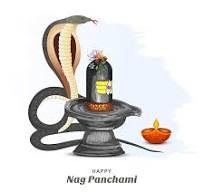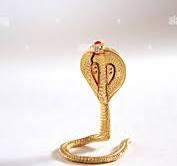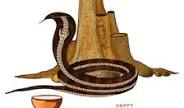#Nag Panchami
Nag Panchami is a traditional Hindu festival that is dedicated to the worship of snakes, especially the Nagas, who are believed to hold a significant place in Hindu mythology and religious practices. Celebrated primarily in India and Nepal, this festival typically falls on the fifth day (Panchami) of the bright half of the lunar month of Shravana (July/August), which is during the monsoon season. The festival has deep religious and cultural significance, connecting people to ancient beliefs, nature, and the agricultural cycle.
Table of Contents
#Mythological Significance of Nagas
The worship of snakes, or Nagas, in Hinduism has roots deeply embedded in ancient scriptures and myths. Nagas are semi-divine serpent beings who reside in the underworld (Patala) and are closely associated with water bodies, fertility, and the earth’s riches. They are revered as protectors of treasures and are often depicted as guardians of the realms of the gods.
One of the most prominent stories related to Nag Panchami is that of Lord Krishna subduing the serpent Kaliya, who had poisoned the Yamuna River. The legend narrates how Krishna, as a young boy, fearlessly danced on Kaliya’s many hoods, subduing him and restoring the river’s purity. This event is celebrated as a victory of good over evil, and Krishna’s act of compassion towards Kaliya, who was spared and banished instead of being killed, reflects the ethos of forgiveness in Hindu culture.
Another significant myth is that of Lord Shiva, who is often depicted with a snake coiled around his neck. This serpent, Vasuki, is believed to symbolize the endless cycle of time and the eternal nature of Shiva. During Samudra Manthan (the churning of the ocean), Vasuki served as the churning rope, further emphasizing the powerful role of serpents in Hindu cosmology.

#Cultural Practices and Rituals
Nag Panchami is marked by a variety of rituals that are performed with great devotion across different regions. The worship of live snakes, particularly cobras, is central to the festival. Devotees often offer milk, sweets, flowers, and even live rats to the snakes as offerings. In some areas, images or idols of Nagas are worshiped instead of live snakes. The rituals may vary, but the underlying belief is that by worshiping the Nagas, devotees seek protection from snake bites and other forms of harm.
In the rural parts of India, it is common to visit snake pits, where priests or snake charmers bring live cobras for worship. The snakes are bathed in milk, and prayers are offered to them. In some traditions, women draw images of Nagas on the walls of their homes using a mixture of cow dung and turmeric, which are then worshiped with offerings of milk and durva grass.
An important aspect of Nag Panchami is the abstinence from plowing fields, digging the earth, or cutting trees. This is done to avoid accidentally harming any snakes that may be residing in the soil. The festival is, therefore, a reminder of the harmonious relationship between humans and nature.

#Regional Variations
Nag Panchami is celebrated differently across various regions of India, each with its own unique customs and traditions. In Maharashtra, the festival is celebrated with great enthusiasm. Women dress in traditional attire and visit temples to offer milk to the images of snakes. In some parts of Karnataka, a ritual called “Nagabali” is performed, where devotees recreate the mythical serpent sacrifice mentioned in the scriptures.
In Bengal, the festival coincides with the celebration of Manasa Devi, the serpent goddess who is revered as the protector against snake bites and other dangers. Here, the focus is more on the worship of the goddess rather than the Nagas themselves.
In the state of Odisha, a festival called “Garuda Panchami” is observed, which honors the mythical bird Garuda, the enemy of serpents. The dual celebration of Nag Panchami and Garuda Panchami reflects the complex interplay of mythologies and the coexistence of different belief systems within Hinduism.

#Scientific and Environmental Aspects
While Nag Panchami is rooted in religious beliefs, it also carries significant environmental messages. The festival occurs during the monsoon season when snakes are more likely to emerge from their burrows due to the rain. The worship of snakes during this period can be seen as a form of reverence towards nature and the ecological role that snakes play in maintaining the balance of the environment.
Snakes are crucial in controlling the population of rodents and other pests that can cause damage to crops. By worshiping snakes, ancient communities acknowledged their importance in the agricultural cycle and sought to live in harmony with them. The festival also serves as a reminder to avoid unnecessary harm to these creatures, which are often misunderstood and feared.
#Nag Panchami in Contemporary Times
In modern times, the celebration of Nag Panchami continues to be an important cultural event, but it also faces challenges due to changing attitudes and environmental concerns. The traditional practice of offering milk to snakes has been criticized by animal rights activists, who argue that it is harmful to the snakes. The practice of capturing wild snakes for the festival is also seen as unethical and illegal under wildlife protection laws.
indianfastearning.comhttp://Nag Panchami
#Conclusion
Nag Panchami is more than just a festival; it is a reflection of the deep connection between religion, culture, and nature in Hindu society. The worship of snakes, despite the fear they evoke, underscores a broader spiritual belief in the sanctity of all life forms and the importance of living in harmony with nature.
As India continues to modernize, the way Nag Panchami is celebrated may evolve, but its core values—respect for nature, reverence for life, and the celebration of cultural heritage—will likely continue to hold relevance for generations to come. The festival serves as a reminder of the ancient wisdom that recognizes the interconnectedness of all living beings and the need to protect the natural world.
wwwutube.com https://www.youtube.com/watch?v=gXx4TYgWrVo&pp=ygUMbmFnIHBhbmNoYW1p







